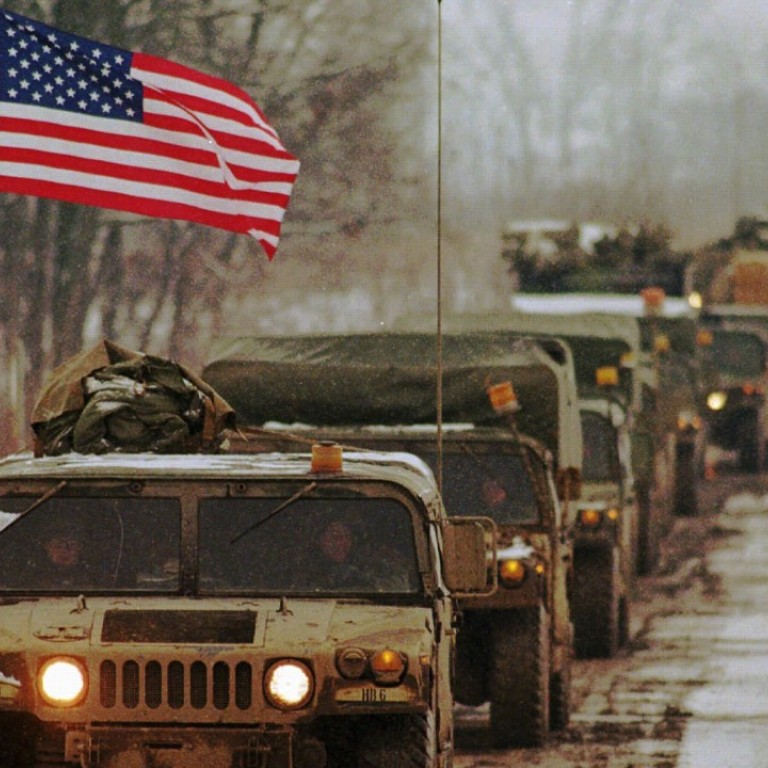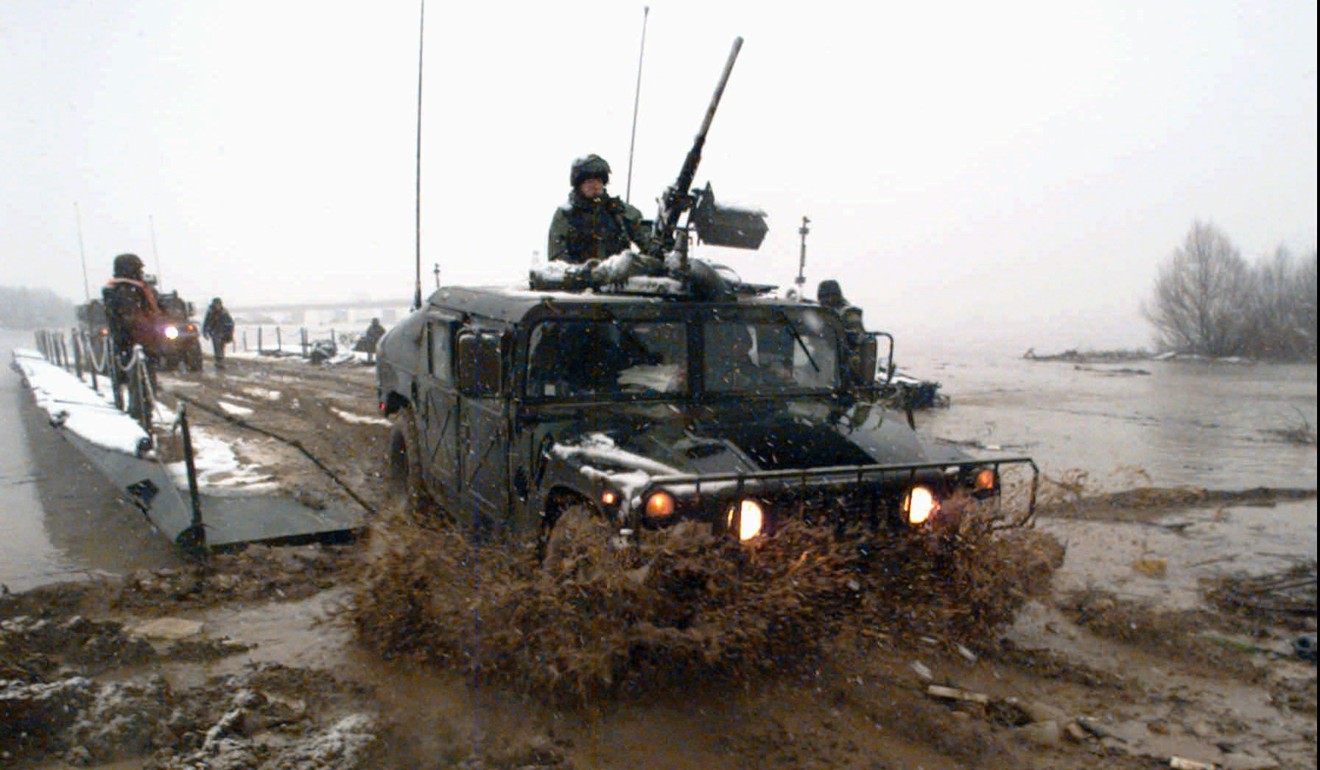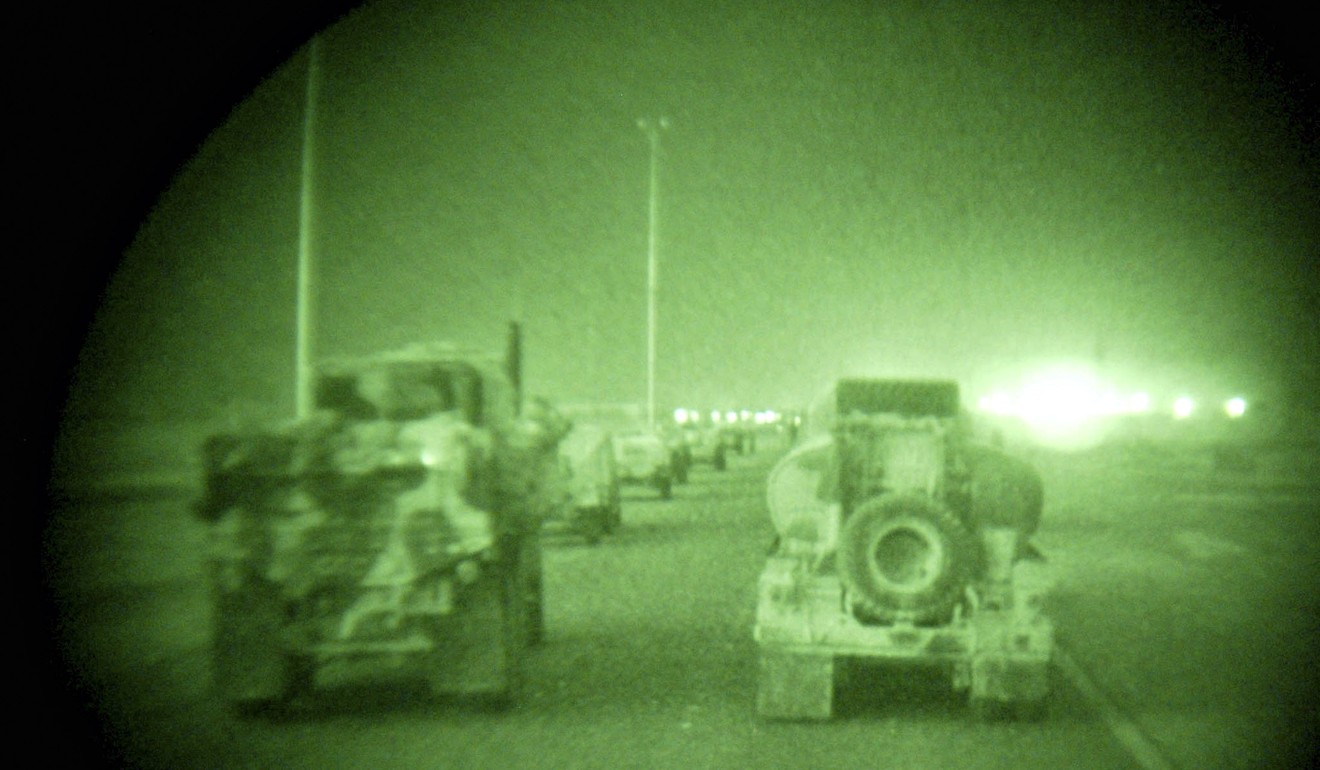
On the road to war with Russia, traffic may be biggest US enemy
Basic logistical challenges such as narrow roads, flimsy bridges and a tangle of bureaucracy mean Nato troops and weaponry could be too slow to move should Russia launch a lightning seizure of Nato territory in the Baltics
US commanders are worried that if they had to head off a conflict with Russia, the most powerful military in the world could get stuck in a traffic jam.
Humvees could snarl behind plodding semis on narrow roads as they made their way east across Europe. US tanks could crush rusting bridges too weak to hold their weight. Troops could be held up by officious passport-checkers and stubborn railway companies.
Although many barriers would drop away if there were a declaration of war, the hazy period before a military engagement would present a major problem. Nato has just a skeleton force deployed to its member countries that share a border with Russia. Backup forces would need to traverse hundreds of miles. And the delays – a mixture of bureaucracy, bad planning and decaying infrastructure – could enable Russia to seize Nato territory in the Baltics while US Army planners were still filling out the 17 forms needed to cross Germany and into Poland.

That possibility is tangible for troops who have got stuck trying to move between training exercises in Europe – like the US Army squadron that budgeted two weeks last year to get their Stryker armoured vehicles back by train to Germany from the Black Sea nation of Georgia. It took four months, leaving the troops sitting in Germany without their rides or weaponry, said Lieutenant Colonel Adam Lackey, the commander of the squadron.
If you can get there in 45 days, you’re just late to the fight
“We have to be able to move as fast or faster than Russia in order to be an effective deterrent,” said Ben Hodges, the US Army’s former top general in Europe.
Since retiring in December, Hodges has devoted himself to raising the alarm from his perch at the Washington-based Centre for European Policy Analysis, and he has successfully pushed to get troop-mobility issues on the agenda of a Nato summit in Brussels next month. The United States and Nato, Hodges said, need to be able to “mass enough capability in place so that Russia doesn’t make a terrible miscalculation.”
The original rationale for the Nato alliance was to defend against a potential war with Russia. Western troops regularly practised for large-scale conflict – and the front line between East and West Germany was just miles away from where more than 200,000 US troops were deployed.
But when the Soviet Union collapsed in 1991, Western planners cheerfully threw away the playbooks in the hope of new cooperation with Moscow. For years after Nato’s 2004 expansion into territory that had once been the Soviet Union’s, the alliance had no plans for how to defend its new members.
“We didn’t think about enlargement in those military terms,” said Douglas Lute, a retired three-star US Army general and former US ambassador to Nato, who as a young officer patrolled the internal German border a short trip away from where he was stationed.

“Transportation is a problem in a very practical way. But it’s a symptom of a bigger problem,” Lute said. “We’re now confronting the image that we had for the last 25 years, of Europe whole, free and at peace. It’s not whole, it’s not free, and it’s not at peace.”
In some cases, military planners in Moscow had a better picture of bridges, roads and the weak points of the new Nato territories – because they used to be the Soviet Union’s.
And whereas Russia has no challenge moving its troops inside its own territory, a thicket of peacetime rules has complicated military movements within Europe.
Germany, for instance, allows trucks loaded with tanks and other heavy equipment on highways only at night on weekdays. Sweden, which isn’t a member of Nato but works closely with the alliance, requires three weeks’ notice before most military personnel and equipment can enter. The rails on Baltic railways are set apart wider than the Western standard, meaning that trains have to be laboriously unloaded, then reloaded near Poland’s border with Lithuania. That can add days to a major movement of troops.
“If you can get there in 45 days, you’re just late to the fight,” said Major General Steven Shapiro, the two-star officer charged with organising the US Army’s movements in Europe. Shapiro noted he recently had to file 17 forms to get troops from the German port of Bremerhaven to their destination in Poland. “There are days where we move at the speed of war. But, generally speaking, that’s outside of the current norm.”
The Baltics could be the place where Russia tests all of Nato. If it fails, all of Nato fails
For example, there was the ordeal of the US Army squadron that needed to bring its equipment back from Georgia to Germany last year.
“On the 15th of August, we finished our mission,” said Lackey, the squadron’s commander. “Some vehicles didn’t return until late December.”
Obstacles quickly piled up. Hungarian border guards didn’t like the Romanian-approved way the Stryker armoured vehicles were chained to railcars, so the chains on all 12 trainloads had to come off and be refastened, Lackey said. One inspector flunked the convoy on Thursday, took the weekend off and came back days later. The Strykers missed their narrow window in Germany’s teeming rail network and had to wait in line behind commuter and commercial train traffic.
“They don’t care if you’re US Army Europe,” Lackey said. “They’re Deutsche Bahn.”
The squadron ended up having to train back in Germany without their specialised vehicles – a bit like forcing Formula One drivers to run sprints because their racing cars are stuck on a trailer. Once the Strykers finally arrived, the troops discovered that the lashing rains and snow of a European autumn doubled the amount of maintenance needed to get them back into fighting shape, Lackey said.
If a crisis had broken out while the soldiers waited, they wouldn’t have been ready to roll out.
Lackey’s squadron is now leading a Nato deployment in northeastern Poland. This time around, he said, “we will drive everywhere.”
Nato leaders are just beginning to address the underlying issues. They have worked with the European Union in the past year to boost funding for infrastructure and reduce bureaucratic roadblocks. At the Brussels summit next month – barring surprises from US President Donald Trump, who has frequently complained that other Nato nations are not spending enough on defence – they are expected to approve two new military commands that would speed transit from the East Coast of the United States all the way to Nato’s border with Russia. That would boost the number of people working full-time to solve the problems, which even still will take years to eliminate.
In a related move, leaders are also expected to approve plans to increase the number of Nato troops that could make the rapid journey if needed, to about 30,000 within 30 days. Nato currently has a rapid-reaction force of 5,000 troops on standby to deploy within 10 days, and military planners fear that is not enough.
Taken together, these changes would mark a significant boost in Nato’s efforts to try to deter Russia, although they would not come close to the military resources that were ready for a short-notice fight at cold war heights.
The hope is that they can avoid war by being able to rush troops to scare off the enemy across the border. “As long as we can provide credible and strong deterrence, including the ability to move forces, then we are preventing conflict,” Nato Secretary General Jens Stoltenberg said this month.
The trickiest spot to defend in all of Nato is likely the narrow strip of land that connects Lithuania to Poland. The 65km-wide corridor is hemmed in by the Russian exclave of Kaliningrad on one side and Belarus, a Russian ally, on the other. It is the Baltic nations’ lifeline to the rest of Nato – and the connection is through a single rail line on the wrong gauge and one usable two-lane highway over rolling terrain that switches from lakes to forests to farmland.
Worried Western officials have started calling the area the Suwalki gap, taking inspiration from the Fulda Gap that was the weakest point in cold war-era defences of West Germany.
The Suwalki area is well within range of sophisticated Russian anti-aircraft missiles stationed in Kaliningrad, so in combat simulations, Nato commanders have hesitated to send warplanes near the region. That led to the Baltics quickly being seized. Any troops coming in on the ground would have to fight without air support – and their entry into the region could be halted by something as simple as a single overturned truck on the highway.
“The place that is most vulnerable to this kind of a rapid strike is the Suwalki corridor region,” said Hodges, the former commander of the US Army in Europe, who has been working on a report about how to bolster the area’s defences.
Now, camouflaged troop carriers ply the region’s roads, some of which are so narrow they don’t have lane markings to divide each direction of traffic. Long columns of cars can pile up behind slow-moving trucks on the main route into Lithuania; the only alternative is a country road that can’t handle heavy traffic. Lumbering Belarus-built tractors can sometimes make the traffic move even more slowly.
The vulnerability means that if Russian troops were massing across the border, Nato would need to deploy – fast. A 2016 study from the Rand Corp found that Russia could seize the Latvian capital of Riga in 60 hours or less.
“We cannot change the geography,” said Lieutenant Colonel Mindaugas Petkevicius, the deputy commander of a Nato logistics team based in Lithuania. “It’s a natural choke point.”
Inside Lithuania’s military headquarters, the need for speed is on stark display. Packed rucksacks stand on top of the closets in every office so that workers can mobilise immediately if war breaks out. Computer keyboards have Cyrillic-alphabet overlays, the better to communicate with Russian and Belarusan counterparts.
“The Baltics could be the place where Russia tests all of Nato,” said the officer who runs logistics for the Lithuanian Defence Ministry, Lieutenant Colonel Valdas Dambrauskas. “If it fails, all of Nato fails.”

